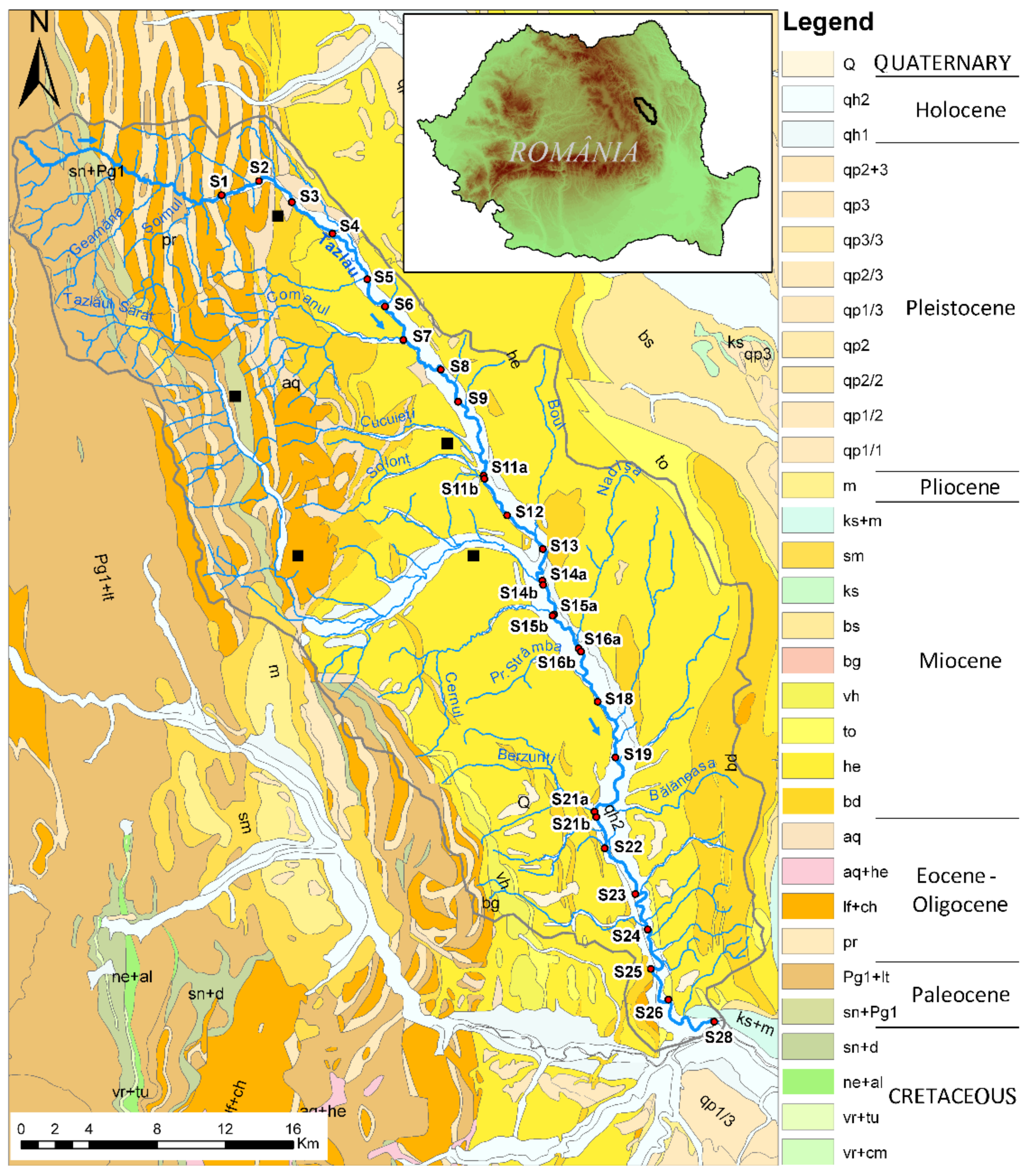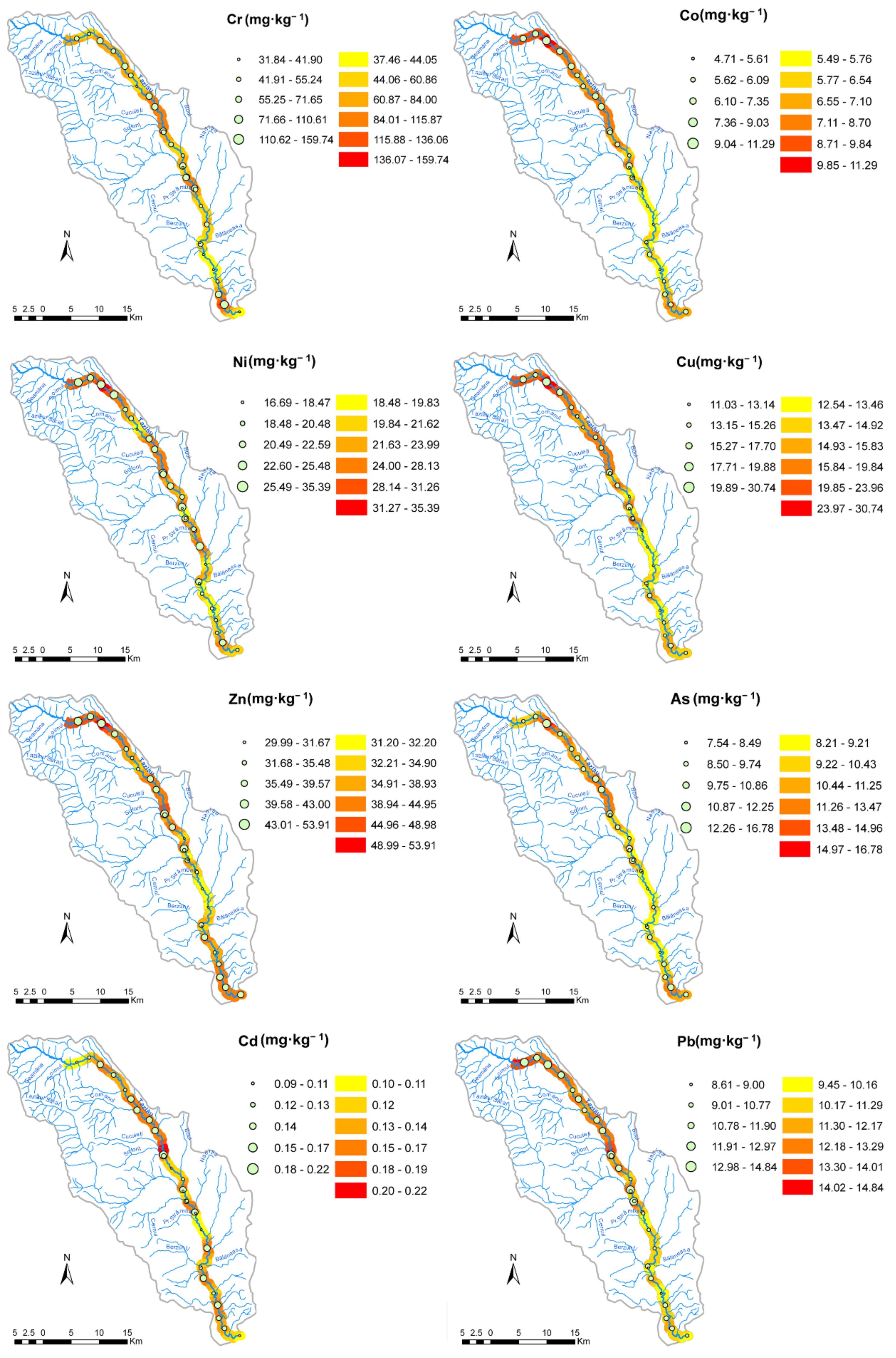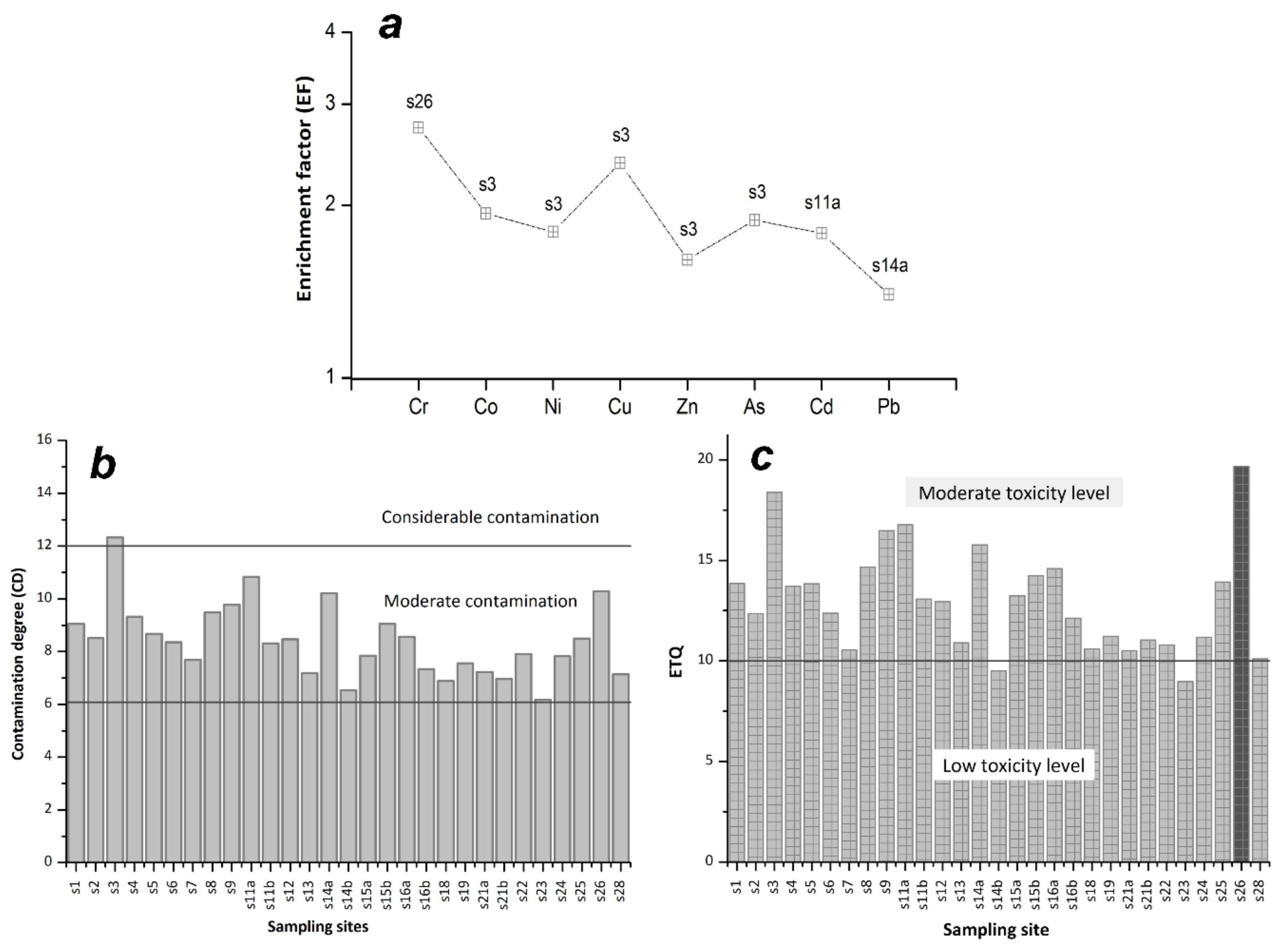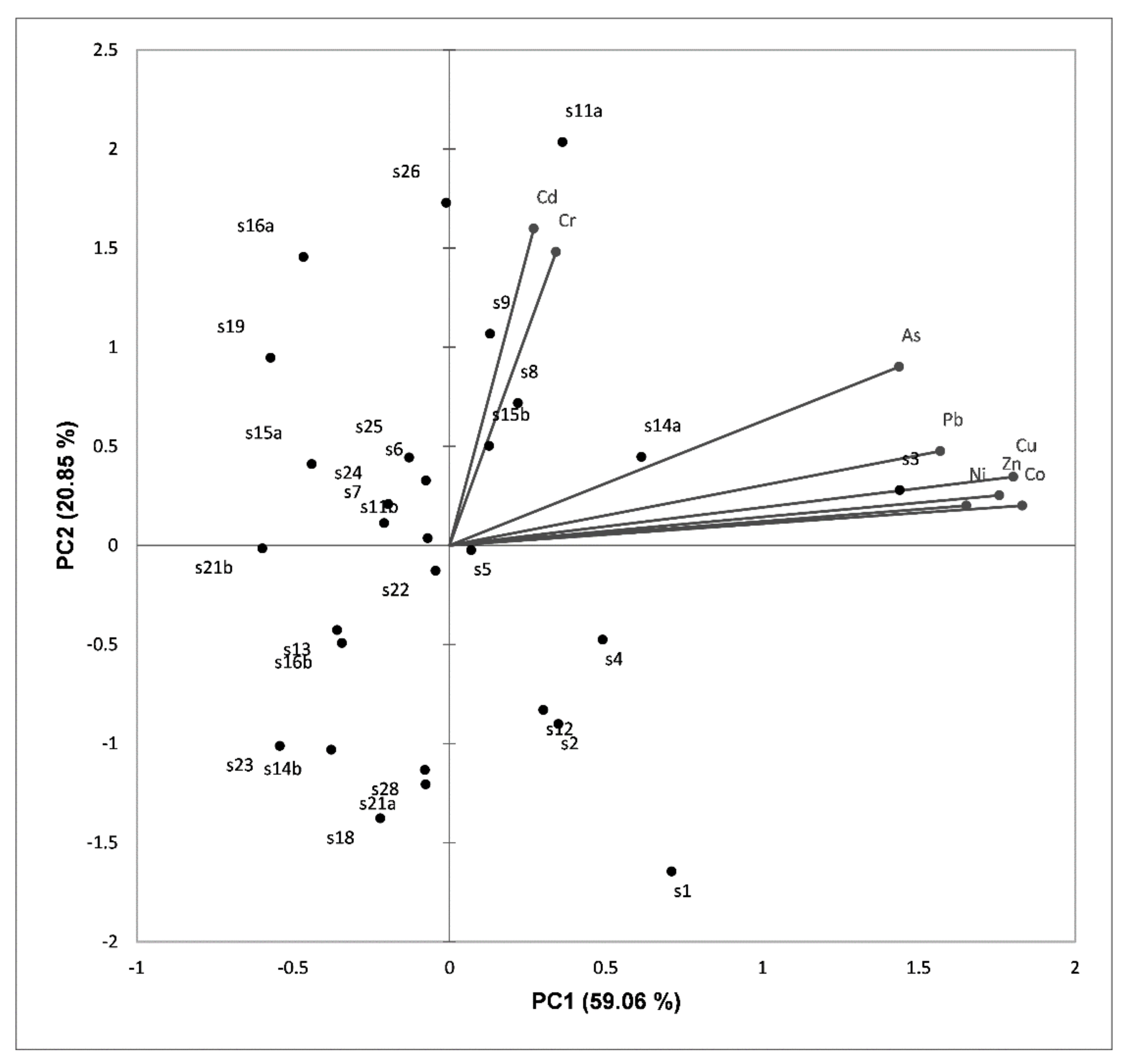Spatial Distribution of Minor Elements in the Tazlău River Sediments: Source Identification and Evaluation of Ecological Risk
Abstract
1. Introduction
2. Materials and Methods
2.1. Study Area and Sampling Sites
2.2. Sample Collection and Chemical Analysis
2.3. Assessment of Sediment Pollution
2.3.1. Enrichment Factor (EF)
2.3.2. Contamination Degree (CD)
2.3.3. Environmental Toxicity Quotient (ETQ)
2.3.4. Health Risk Analysis
2.4. Statistical Analysis
3. Results and Discussion
3.1. Sediments Chemistry
3.2. Estimation of Superficial Sediment Contamination and Ecotoxicological Risks
3.3. Relationships between Elements and PCA
4. Conclusions
Author Contributions
Funding
Conflicts of Interest
References
- Dou, Y.; Li, J.; Zhao, J.; Hu, B.; Yang, S. Distribution, enrichment and source of heavy metals in surface sediments of the eastern Beibu Bay, South China Sea. Mar. Pollut. Bull. 2013, 67, 137–145. [Google Scholar] [CrossRef] [PubMed]
- Zhang, G.; Bai, J.; Xiao, R.; Zhao, Q.; Jia, J.; Cui, B.; Liu, X. Heavy metal fractions and ecological risk assessment in sediments from urban, rural and reclamation-affected rivers of the Pearl River Estuary, China. Chemosphere 2017, 184, 278–288. [Google Scholar] [CrossRef] [PubMed]
- Maftei, A.E.; Iancu, O.G.; Buzgar, N. Assessment of minor elements contamination in Bistriţa River sediments (upstream of Izvorul Muntelui Lake, Romania) with the implication of mining activity. J. Geochem. Explor. 2014, 145, 25–34. [Google Scholar] [CrossRef]
- Malvandi, H. Preliminary evaluation of heavy metal contamination in the Zarrin-Gol River sediments, Iran. Mar. Pollut. Bull. 2017, 117, 547–553. [Google Scholar] [CrossRef]
- Qu, C.; Li, B.; Wu, H.; Wang, S.; Li, F. Probabilistic ecological risk assessment of heavy metals in sediments from China’s major aquatic bodies. Stoch. Environ. Res. Risk Assess. 2015, 30, 271–282. [Google Scholar] [CrossRef]
- Shen, F.; Mao, L.; Sun, R.; Du, J.; Tan, Z.; Ding, M. Contamination Evaluation and Source Identification of Heavy Metals in the Sediments from the Lishui River Watershed, Southern China. Int. J. Environ. Res. Public Health 2019, 16, 336. [Google Scholar] [CrossRef]
- Gao, L.; Wang, Z.; Li, S.; Chen, J. Bioavailability and toxicity of trace metals (Cd, Cr, Cu, Ni, and Zn) in sediment cores from the Shima River, South China. Chemosphere 2018, 192, 31–42. [Google Scholar] [CrossRef]
- Green, A.J.; Planchart, A. The neurological toxicity of heavy metals: A fish perspective. Comp. Biochem. Physiol. C Toxicol. Pharmacol. 2017, 208, 12–19. [Google Scholar] [CrossRef]
- Sakan, S.; Devic, G.; Relic, D.; Andelkovic, I.; Sakan, N.; Dordevic, D. Evaluation of sediment contamination with heavy metals: The importance of determining appropriate background content and suitable element for normalization. Environ. Geochem. Health 2015, 37, 97–113. [Google Scholar] [CrossRef]
- Singh, H.; Yadav, S.; Singh, B.K.; Dubey, B.; Tripathi, K.; Srivastava, V.; Shukla, D.N. Assessment of Geochemical Environment from Study of River Sediments in the Middle Stretch of River Ganga at Ghazipur, Buxar and Ballia area. Proc. Natl. Acad. Sci. India Sect. B Biol. Sci. 2013, 83, 371–384. [Google Scholar] [CrossRef]
- Grasu, C.; Catană, C.; Grinea, D. Carphatian Flysch. Petrographical and Economical Considerations. Editura Tehnică București: Bucharest, Romania, 1988. (In Romanian) [Google Scholar]
- Pawlewicz, M. Total Petroleum Systems of the Carpathian–Balkanian Basin Province of Romania and Bulgaria, Bulletin 2204–F.; U.S. Geological Survey: Tallahassee, FL, USA, 2007. [Google Scholar]
- Ţabără, D.; Pacton, M.; Makou, M.; Chirilă, G. Palynofacies and geochemical analysis of Oligo-Miocene bituminous rocks from the Moldavidian Domain (Eastern Carpathians, Romania): Implications for petroleum exploration. Rev. Palaeobot. Palynol. 2015, 216, 101–122. [Google Scholar] [CrossRef]
- Sachsenhofer, R.F.; Hentschke, J.; Bechtel, A.; Coric, S.; Gratzer, R.; Gross, D.; Horsfield, B.; Rachetti, A.; Soliman, A. Hydrocarbon potential and depositional environments of Oligo—Miocene rocks in the Eastern Carpathians (Vrancea Nappe, Romania). Mar. Pet. Geol. 2015, 68, 269–290. [Google Scholar] [CrossRef]
- Maftei, A.E.; Dill, H.G.; Buzatu, A.; Iancu, O.G.; Buzgar, N.; Andras, P. Chemical and mineralogical composition of fluvial sediments (Bistrita River, Romania): Geogenic vs. anthropogenic input into rivers on its way through mining areas. Geochemistry 2018, 78, 385–395. [Google Scholar] [CrossRef]
- Xu, F.; Liu, Z.; Cao, Y.; Qiu, L.; Feng, J.; Xu, F.; Tian, X. Assessment of heavy metal contamination in urban river sediments in the Jiaozhou Bay catchment, Qingdao, China. Catena 2017, 150, 9–16. [Google Scholar] [CrossRef]
- Murgeanu, G.; Dumitrescu, I.; Mirăuţă, D.; Săndulescu, M.; Ştefănescu, M.; Bandrabur, T. Geological Map of Romania, 1:200.000 Scale, 21-Bacau Sheet; Institutul Geologic al României: Bucureşti, Romania, 1968. [Google Scholar]
- Murgeanu, G.; Mirăuţă, D. Geological Map of Romania, 1:200.000 Scale, 13-Piatra Neamt Sheet; Institutul Geologic al României: Bucureşti, Romania, 1968. [Google Scholar]
- Islam, M.A.; Al-Mamun, A.; Hossain, F.; Quraishi, S.B.; Naher, K.; Khan, R.; Das, S.; Tamim, U.; Hossain, S.M.; Nahid, F. Contamination and ecological risk assessment of trace elements in sediments of the rivers of Sundarban mangrove forest, Bangladesh. Mar. Pollut. Bull. 2017, 124, 356–366. [Google Scholar] [CrossRef]
- Kumar, S.P.; Edward, J.K.P. Assessment of metal concentration in the sediment cores of Manakudy estuary, south west coast of India. Indian J. Mar. Sci. 2009, 38, 235–248. [Google Scholar]
- Krishna, A.K.; Mohan, K.R.; Murthy, N.N. A Multivariate Statistical Approach for Monitoring of Heavy Metals in Sediments: A Case Study from Wailpalli Watershed, Nalgonda District, Andhra Pradesh, India. Res. J. Environ. Earth Sci. 2011, 3, 103–113. [Google Scholar]
- Reimann, C.; Filzmoser, P.; Garrett, R.G. Background and threshold: Critical comparison of methods of determination. Sci. Total. Environ. 2005, 346, 1–16. [Google Scholar] [CrossRef]
- Hakanson, L. An ecological risk index for aquatic pollution control. A sedimentological approach. Water Res. 1980, 14, 975–1001. [Google Scholar] [CrossRef]
- Benabdelkader, A.; Taleb, A.; Probst, J.L.; Belaidi, N.; Probst, A. Anthropogenic contribution and influencing factors on metal features in fluvial sediments from a semi-arid Mediterranean river basin (Tafna River, Algeria): A multi-indices approach. Sci. Total. Environ. 2018, 626, 899–914. [Google Scholar] [CrossRef]
- Ali, A.E.; Strezov, V.; Davies, P.J.; Wright, I. River sediment quality assessment using sediment quality indices for the Sydney basin, Australia affected by coal and coal seam gas mining. Sci. Total Environ. 2018, 616–617, 695–702. [Google Scholar] [CrossRef] [PubMed]
- ASTDR. The Priority List of Hazardous Substances; ASTDR: Atlanta, GA, USA, 2017. [Google Scholar]
- Kusin, F.M.; Azani, N.N.M.; Hasan, S.N.M.S.; Sulong, N.A. Distribution of heavy metals and metalloid in surface sediments of heavily-mined area for bauxite ore in Pengerang, Malaysia and associated risk assessment. Catena 2018, 165, 454–464. [Google Scholar] [CrossRef]
- Wang, Y.B.; Liu, C.W.; Kao, Y.H.; Jang, C.S. Characterization and risk assessment of PAH-contaminated river sediment by using advanced multivariate methods. Sci. Total. Environ. 2015, 524–525, 63–73. [Google Scholar] [CrossRef]
- Wang, Y.B.; Liu, C.W.; Wang, S.W. Characterization of heavy-metal-contaminated sediment by using unsupervised multivariate techniques and health risk assessment. Ecotoxicol. Environ. Saf. 2015, 113, 469–476. [Google Scholar] [CrossRef]
- Iqbal, J.; Tirmizi, S.A.; Shah, M.H. Statistical apportionment and risk assessment of selected metals in sediments from Rawal Lake (Pakistan). Environ. Monit. Assess. 2013, 185, 729–743. [Google Scholar] [CrossRef]
- USEPA. Risk Assessment Guidance for Superfund; Human Health Evaluation Manual (Part E), Report EPA/540/R/99/005; USEPA: Washington, DC, USA, 2004; Volume 1.
- Ferreira-Baptista, L.; De Miguel, E. Geochemistry and risk assessment of street dust in Luanda, Angola: A tropical urban environment. Atmos. Environ. 2005, 39, 4501–4512. [Google Scholar] [CrossRef]
- Yu, Y.; Ma, J.; Song, N.; Wang, X.; Wei, T.; Yang, Z.; Li, Y. Comparison of metal pollution and health risks of urban dust in Beijing in 2007 and 2012. Environ. Monit. Assess. 2016, 188, 657. [Google Scholar] [CrossRef]
- USEPA. Exposure Factors Handbook; EPA/600/R-09/052F; National Center for Environmental Assessment; USEPA: Washington, DC, USA, 2011.
- Yuswir, N.S.; Praveena, S.M.; Aris, A.Z.; Ismail, S.N.; Hashim, Z. Health Risk Assessment of Heavy Metal in Urban Surface Soil (Klang District, Malaysia). Bull. Environ. Contam. Toxicol. 2015, 95, 80–89. [Google Scholar] [CrossRef]
- Al-Khashman, O.A. Determination of metal accumulation in deposited street dusts in Amman, Jordan. Environ. Geochem. Health 2007, 29, 1–10. [Google Scholar] [CrossRef]
- Kassenaar, J.D.C. An application of principal components analysis to borehole geophysical data. In Proceedings of the 4th International MGLS/KEGS Symposium on Borehole Geophysics for Minerals, Geotechnical and Groundwater Applications, Toronto, ON, Canada, 18–22 August 1991. [Google Scholar]
- Marques, W.S.; Sial, A.N.; de Albuquerque Menor, E.; Ferreira, V.P.; Freire, G.S.S.; de Albuquerque Medeiros Lima, E.; do Amaral Vaz Manso, V. Principal component analysis (PCA) and mineral associations of litoraneous facies of continental shelf carbonates from northeastern Brazil. Cont. Shelf Res. 2008, 28, 2709–2717. [Google Scholar] [CrossRef]
- Belkhiri, L.; Mouni, L.; Sheikhy Narany, T.; Tiri, A. Evaluation of potential health risk of heavy metals in groundwater using the integration of indicator kriging and multivariate statistical methods. Groundw. Sustain. Dev. 2017, 4, 12–22. [Google Scholar] [CrossRef]
- Adesodun, J.K.; Mbagwu, J.S. Distribution of heavy metals and hydrocarbon contents in an alfisol contaminated with waste-lubricating oil amended with organic wastes. Bioresour. Technol. 2008, 99, 3195–3204. [Google Scholar] [CrossRef] [PubMed]
- Essiett, U.A.; Effiong, G.S.; Ogbemudia, F.O.; Bruno, E.J. Heavy metal concentrations in plants growing in crude oil contaminated soil in Akwa Ibom State, South-Eastern Nigeria. Afr. J. Pharm. Pharmacol. 2010, 4, 465–470. [Google Scholar]
- Muniz, P. Assessment of contamination by heavy metals and petroleum hydrocarbons in sediments of Montevideo Harbour (Uruguay). Environ. Int. 2004, 29, 1019–1028. [Google Scholar] [CrossRef]
- Yang, X.; Yuan, X.; Zhang, A.; Mao, Y.; Li, Q.; Zong, H.; Wang, L.; Li, X. Spatial distribution and sources of heavy metals and petroleum hydrocarbon in the sand flats of Shuangtaizi Estuary, Bohai Sea of China. Mar. Pollut. Bull. 2015, 95, 503–512. [Google Scholar] [CrossRef]
- Hackley, P.C.; SanFilipo, J.R. Organic petrology and geochemistry of Eocene Suzak bituminous marl, north-central Afghanistan: Depositional environment and source rock potential. Mar. Pet. Geol. 2016, 73, 572–589. [Google Scholar] [CrossRef]
- Sokol, E.V.; Kozmenko, O.A.; Khoury, H.N.; Kokh, S.N.; Novikova, S.A.; Nefedov, A.A.; Sokol, I.A.; Zaikin, P. Calcareous sediments of the Muwaqqar Chalk Marl Formation, Jordan: Mineralogical and geochemical evidences for Zn and Cd enrichment. Gondwana Res. 2017, 46, 204–226. [Google Scholar] [CrossRef]
- Rosolen, V.; De-Campos, A.B.; Govone, J.S.; Rocha, C. Contamination of wetland soils and floodplain sediments from agricultural activities in the Cerrado Biome (State of Minas Gerais, Brazil). Catena 2015, 128, 203–210. [Google Scholar] [CrossRef]
- Kabata-Pendias, A.; Mukherjee, A.B. Trace Elements from Soil to Human; Springer: New York, NY, USA, 2007. [Google Scholar] [CrossRef]
- Dai, L.; Wang, L.; Li, L.; Liang, T.; Zhang, Y.; Ma, C.; Xing, B. Multivariate geostatistical analysis and source identification of heavy metals in the sediment of Poyang Lake in China. Sci. Total. Environ. 2018, 621, 1433–1444. [Google Scholar] [CrossRef]
- Vu, C.T.; Lin, C.; Shern, C.-C.; Yeh, G.; Le, V.G.; Tran, H.T. Contamination, ecological risk and source apportionment of heavy metals in sediments and water of a contaminated river in Taiwan. Ecol. Indic. 2017, 82, 32–42. [Google Scholar] [CrossRef]
- Ali, M.M.; Ali, M.L.; Islam, M.S.; Rahman, M.Z. Preliminary assessment of heavy metals in water and sediment of Karnaphuli River, Bangladesh. Environ. Nanotechnol. Monit. Manag. 2016, 5, 27–35. [Google Scholar] [CrossRef]
- Bhuyan, M.S.; Bakar, M.A.; Akhtar, A.; Hossain, M.B.; Ali, M.M.; Islam, M.S. Heavy metal contamination in surface water and sediment of the Meghna River, Bangladesh. Environ. Nanotechnol. Monit. Manag. 2017, 8, 273–279. [Google Scholar] [CrossRef]
- APM. Annual Report on the State of the Environment in Bacau County; National Environmental Protection Agency: Bacau, Romania, 2009. [Google Scholar]




| Cr | Co | Ni | Cu | Zn | As | Cd | Pb | |
|---|---|---|---|---|---|---|---|---|
| (mg/kg) | ||||||||
| Mean | 68.31 | 6.87 | 23.01 | 15.81 | 38.60 | 10.23 | 0.14 | 11.66 |
| s.d. | 27.87 | 1.43 | 4.15 | 3.80 | 6.04 | 1.77 | 0.03 | 1.60 |
| Min | 31.84 | 4.71 | 16.69 | 11.03 | 29.99 | 7.54 | 0.1 | 8.61 |
| Max | 160 | 11.29 | 35.39 | 30.74 | 53.91 | 16.78 | 0.22 | 14.84 |
| Median | 62.58 | 6.56 | 22.59 | 15.09 | 38.68 | 10.22 | 0.14 | 11.42 |
| Kurtosis | 2.75 | 1.76 | 1.33 | 7.64 | 0.11 | 5.72 | 1.39 | −0.57 |
| Skewness | 1.27 | 1.09 | 0.90 | 2.24 | 0.64 | 1.69 | 0.71 | 0.18 |
| Variance | 777 | 2.04 | 17.24 | 14.47 | 3.13 | 3.13 | 0.001 | 2.55 |
| Geochemical background | 29–96 | 4.52–8.60 | 17–28 | 11–19 | 30–47 | 8–13 | 0.10–0.17 | 9–14 |
| Geochemical threshold | 96 | 8.60 | 28 | 19 | 47 | 13 | 0.17 | 14 |
| Background mean | 60 | 6.55 | 22 | 15 | 38 | 10 | 0.13 | 11 |
| Romanian sediment quality guidelines | 100 | – | 35 | 40 | 150 | 29 | 0.8 | 85 |
| Sites and Indices | Enrichment Factors (EF) | ETQ | CD | |||||||
|---|---|---|---|---|---|---|---|---|---|---|
| Cr | Co | Ni | Cu | Zn | As | Cd | Pb | |||
| S1 | 0.96 | 1.36 | 1.23 | 1.34 | 1.23 | 0.89 | 0.67 | 1.24 | 13.85 | 9.05 |
| S2 | 0.80 | 1.29 | 1.06 | 1.12 | 1.11 | 1.00 | 0.89 | 1.09 | 12.34 | 8.52 |
| S3 | 1.58 | 1.93 | 1.80 | 2.37 | 1.61 | 1.88 | 1.29 | 1.35 | 18.38 | 12.32 |
| S4 | 0.99 | 1.31 | 1.27 | 1.34 | 1.12 | 1.04 | 1.01 | 1.05 | 13.72 | 9.32 |
| S5 | 1.29 | 1.14 | 0.97 | 1.11 | 1.00 | 1.04 | 0.91 | 1.03 | 13.83 | 8.67 |
| S6 | 1.03 | 1.07 | 0.95 | 1.04 | 0.93 | 1.03 | 1.14 | 1.08 | 12.37 | 8.36 |
| S7 | 0.69 | 0.99 | 0.83 | 1.00 | 0.88 | 1.07 | 1.13 | 1.02 | 10.55 | 7.69 |
| S8 | 1.33 | 1.19 | 1.11 | 1.21 | 1.11 | 1.14 | 1.22 | 1.14 | 14.66 | 9.49 |
| S9 | 1.82 | 1.17 | 1.07 | 1.21 | 1.07 | 1.14 | 1.12 | 1.11 | 16.47 | 9.78 |
| S11a | 1.73 | 1.31 | 1.38 | 1.41 | 1.33 | 1.23 | 1.79 | 1.33 | 16.77 | 10.83 |
| S11b | 1.11 | 0.97 | 1.04 | 0.91 | 0.96 | 0.89 | 0.98 | 0.94 | 13.07 | 8.31 |
| S12 | 0.93 | 1.09 | 1.05 | 1.11 | 1.09 | 1.04 | 0.78 | 1.11 | 12.94 | 8.47 |
| S13 | 0.86 | 0.85 | 0.90 | 0.81 | 0.78 | 0.81 | 0.86 | 0.85 | 10.90 | 7.18 |
| S14a | 1.40 | 1.33 | 1.34 | 1.46 | 1.42 | 1.27 | 1.29 | 1.40 | 15.77 | 10.21 |
| S14b | 0.57 | 0.78 | 0.70 | 0.76 | 0.79 | 0.82 | 0.69 | 0.84 | 9.50 | 6.53 |
| S15a | 1.41 | 0.78 | 0.85 | 0.98 | 0.78 | 0.85 | 0.91 | 0.87 | 13.23 | 7.85 |
| S15b | 1.31 | 1.00 | 1.08 | 1.17 | 1.03 | 1.14 | 1.09 | 1.22 | 14.23 | 9.05 |
| S16a | 1.75 | 0.88 | 0.99 | 0.90 | 0.88 | 0.94 | 1.26 | 0.95 | 14.59 | 8.56 |
| S16b | 1.10 | 0.78 | 0.95 | 0.80 | 0.81 | 0.79 | 0.73 | 0.82 | 12.12 | 7.33 |
| S18 | 0.72 | 0.75 | 1.11 | 0.82 | 0.73 | 0.72 | 0.61 | 0.81 | 10.60 | 6.89 |
| S19 | 1.04 | 0.83 | 0.83 | 0.85 | 0.85 | 0.98 | 1.32 | 0.90 | 11.22 | 7.56 |
| S21a | 0.60 | 0.87 | 0.98 | 0.91 | 0.92 | 0.77 | 0.76 | 0.93 | 10.51 | 7.22 |
| S21b | 1.04 | 0.79 | 0.72 | 0.82 | 0.80 | 0.83 | 0.91 | 0.76 | 11.04 | 6.96 |
| S22 | 0.60 | 0.98 | 0.89 | 1.09 | 1.07 | 1.00 | 1.16 | 1.03 | 10.79 | 7.91 |
| S23 | 0.51 | 0.66 | 0.79 | 0.69 | 0.84 | 0.69 | 0.78 | 0.69 | 8.97 | 6.18 |
| S24 | 0.76 | 0.91 | 0.90 | 0.95 | 1.04 | 1.01 | 1.19 | 0.96 | 11.17 | 7.83 |
| S25 | 1.40 | 1.00 | 0.93 | 1.02 | 1.08 | 1.04 | 1.04 | 1.00 | 13.92 | 8.50 |
| S26 | 2.73 | 1.14 | 1.19 | 1.11 | 1.10 | 1.26 | 1.02 | 1.04 | 19.67 | 10.29 |
| S28 | 0.49 | 0.93 | 0.83 | 0.87 | 0.99 | 0.99 | 0.74 | 0.80 | 10.10 | 7.14 |
| Min | 0.49 | 0.66 | 0.70 | 0.69 | 0.73 | 0.69 | 0.61 | 0.69 | 8.97 | 6.18 |
| Max | 2.73 | 1.93 | 1.80 | 2.37 | 1.61 | 1.88 | 1.79 | 1.40 | 19.67 | 12.32 |
| Average | 1.12 | 1.04 | 1.03 | 1.08 | 1.012 | 1.010 | 1.011 | 1.013 | 13.01 | 8.41 |
| Element | Exposure Assessment | Non-Carcinogenic Risk | Carcinogenic Risk |
|---|---|---|---|
| Expdermal | HQdermal | Cancerdermal * | |
| Cr | 3.73 × 10−07 | 6.22 × 10−03 | 1.87 × 10−07 |
| Co | 3.76 × 10−08 | 2.35 × 10−06 | |
| Ni | 1.26 × 10−07 | 2.33 × 10−05 | |
| Cu | 8.64 × 10−08 | 7.20 × 10−06 | |
| Zn | 2.11 × 10−07 | 3.52 × 10−06 | |
| As | 5.59 × 10−08 | 4.54 × 10−04 | 8.38 × 10−08 |
| Cd | 7.42 × 10−10 | 7.42 × 10−05 | 4.67 × 10−09 |
| Pb | 6.37 × 10−08 | 1.21 × 10−04 | 5.42 × 10−10 |
| HIdermal | 6.90 × 10−3 | ||
| CanRisktotal | 2.76 × 10−7 |
© 2019 by the authors. Licensee MDPI, Basel, Switzerland. This article is an open access article distributed under the terms and conditions of the Creative Commons Attribution (CC BY) license (http://creativecommons.org/licenses/by/4.0/).
Share and Cite
Maftei, A.E.; Buzatu, A.; Buzgar, N.; Apopei, A.I. Spatial Distribution of Minor Elements in the Tazlău River Sediments: Source Identification and Evaluation of Ecological Risk. Int. J. Environ. Res. Public Health 2019, 16, 4664. https://doi.org/10.3390/ijerph16234664
Maftei AE, Buzatu A, Buzgar N, Apopei AI. Spatial Distribution of Minor Elements in the Tazlău River Sediments: Source Identification and Evaluation of Ecological Risk. International Journal of Environmental Research and Public Health. 2019; 16(23):4664. https://doi.org/10.3390/ijerph16234664
Chicago/Turabian StyleMaftei, Andreea E., Andrei Buzatu, Nicolae Buzgar, and Andrei I. Apopei. 2019. "Spatial Distribution of Minor Elements in the Tazlău River Sediments: Source Identification and Evaluation of Ecological Risk" International Journal of Environmental Research and Public Health 16, no. 23: 4664. https://doi.org/10.3390/ijerph16234664
APA StyleMaftei, A. E., Buzatu, A., Buzgar, N., & Apopei, A. I. (2019). Spatial Distribution of Minor Elements in the Tazlău River Sediments: Source Identification and Evaluation of Ecological Risk. International Journal of Environmental Research and Public Health, 16(23), 4664. https://doi.org/10.3390/ijerph16234664





